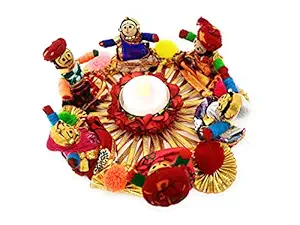परिचय
सीता का रावण द्वारा हरण रामायण की सबसे महत्वपूर्ण घटनाओं में से एक है। यह घटना राम और रावण के बीच महान युद्ध का कारण बनी। छल-कपट का सहारा लेकर रावण ने सीता का अपहरण किया, जिससे अंततः उसका सर्वनाश हुआ।
सोने के मृग की चाल
एक दिन, जब राम, सीता और लक्ष्मण पंचवटी में निवास कर रहे थे, तब एक अद्भुत सोने का मृग उनकी कुटिया के पास आया। इसकी सुंदरता देखकर सीता मोहित हो गईं और उन्होंने राम से इसे पकड़ने की इच्छा जताई।
राम को इस मृग पर संदेह था, लेकिन सीता की इच्छा पूरी करने के लिए वे इसे पकड़ने चले गए। जाने से पहले उन्होंने लक्ष्मण को सीता की रक्षा करने का निर्देश दिया। यह मृग वास्तव में राक्षस मारीच था, जो रावण की योजना में सहायता कर रहा था।
राम ने मृग का पीछा किया, लेकिन यह उन्हें बहुत दूर जंगल में ले गया। जब राम ने इसे बाण से मारा, तो मारीच ने राम की आवाज़ में ‘हे लक्ष्मण! हे सीता!’ पुकार लगाई।
रावण का छल
जब सीता ने यह दर्दभरी आवाज सुनी, तो वे घबरा गईं और लक्ष्मण से तुरंत राम की सहायता करने को कहा। लक्ष्मण ने कहा कि राम कभी संकट में नहीं पड़ सकते, लेकिन सीता ने उन पर कठोर शब्दों से आरोप लगाया। मजबूर होकर लक्ष्मण राम की खोज में चले गए, परंतु जाने से पहले उन्होंने लक्ष्मण रेखा खींच दी और सीता को उसे पार न करने की चेतावनी दी।
जैसे ही लक्ष्मण गए, रावण एक भिक्षु के वेश में आया और भिक्षा माँगने लगा। दयालु सीता ने उसकी सहायता के लिए लक्ष्मण रेखा पार की, और उसी क्षण रावण ने अपना असली रूप प्रकट कर उन्हें बलपूर्वक पुष्पक विमान में बैठाकर लंका की ओर उड़ चला।
जटायु का वीर प्रयास
सीता को ले जाते समय, पक्षीराज जटायु ने रावण को रोकने का प्रयास किया। उसने पूरी शक्ति से रावण पर हमला किया, लेकिन रावण ने उसे गंभीर रूप से घायल कर दिया और उड़ता हुआ लंका चला गया।
घटना का महत्व
इस घटना के बाद, राम ने सीता की खोज का संकल्प लिया और रावण के विरुद्ध युद्ध किया। यह प्रसंग धर्म और अधर्म की लड़ाई को दर्शाता है।
निष्कर्ष
सीता हरण ने रामायण की कहानी को एक निर्णायक मोड़ दिया। यह घटना सिखाती है कि बुराई कितनी भी शक्तिशाली क्यों न हो, अंत में धर्म की ही विजय होती है।
Introduction
Story Overview
The story of Sita's abduction by Ravana is one of the most important episodes in Ramayan. It sets the stage for Lord Rama's battle against Ravana.
Significance
This episode symbolizes the victory of evil through deceit and the importance of vigilance and wisdom.
Characters Involved
The main characters include Lord Rama, Sita, Lakshmana, Ravana, and Maricha who helped in the golden deer trick.
Setting
The event takes place in the forest of Panchvati, where Rama, Sita, and Lakshmana were staying during their exile.
Key Lessons
The abduction teaches lessons about trust, vigilance, the consequences of desire, and the triumph of righteousness.
The Golden Deer Trick
Plan of Ravana
Ravana planned the abduction by sending Maricha disguised as a golden deer to lure Sita and separate her from Rama.
Sita's Curiosity
Sita became fascinated by the golden deer and requested Rama to capture it for her, leading to her separation from him.
Rama Chases the Deer
Rama chased the golden deer deep into the forest, leaving Lakshmana to protect Sita, which was part of Ravana's plan.
Lakshmana's Dilemma
Lakshmana faced a dilemma when Sita insisted Rama was in danger, prompting him to leave her briefly unguarded.
Ravana's Arrival
Ravana took advantage of the moment to appear before Sita, abducting her and taking her to Lanka.
Significance of the Abduction
Symbolism of Evil
Ravana's act symbolizes how evil uses cunning and temptation to achieve its goals.
Role of Virtue
Sita's virtue and devotion highlight the importance of righteousness and steadfastness in the face of adversity.
Rama's Devotion
Rama's immediate response to Sita's abduction shows his dedication and unwavering duty towards dharma.
Impact on the Story
This event triggers the entire chain of events leading to the war in Lanka and the eventual defeat of Ravana.
Moral Teachings
The episode teaches vigilance, discernment, and the consequences of being swayed by appearances.
Ravana's Character
Deceptive Nature
Ravana demonstrates extreme cunning and the ability to manipulate situations to achieve his selfish desires.
Power and Pride
Ravana's pride and power are central to his character, which leads him to underestimate the righteousness of Rama.
Symbol of Temptation
Ravana acts as a symbol of temptation and illusion, which can distract even the virtuous.
Strategic Mind
His planning and strategy in separating Rama and Sita show his tactical thinking despite being morally corrupt.
Downfall Foreshadowed
Ravana's overconfidence and reliance on deceit foreshadow his eventual downfall at the hands of Rama.
Lessons from the Abduction
Be Vigilant
The story teaches that constant vigilance is necessary to protect oneself from deceit and danger.
Importance of Wisdom
Wisdom and discernment are crucial to avoid being misled by appearances or temptations.
Faith and Devotion
Faith and devotion, as shown by Sita and Rama, are powerful tools to overcome adversities.
Consequences of Desire
Desire and attachment can lead to misjudgments, as seen in Sita's fascination with the golden deer.
Triumph of Righteousness
Ultimately, the story emphasizes that dharma and righteousness will triumph over evil and deceit.
The story of Sita's abduction by Ravana is one of the most important episodes in Ramayan. It sets the stage for Lord Rama's battle against Ravana.
This episode symbolizes the victory of evil through deceit and the importance of vigilance and wisdom.
The main characters include Lord Rama, Sita, Lakshmana, Ravana, and Maricha who helped in the golden deer trick.
The event takes place in the forest of Panchvati, where Rama, Sita, and Lakshmana were staying during their exile.
The abduction teaches lessons about trust, vigilance, the consequences of desire, and the triumph of righteousness.
Ravana planned the abduction by sending Maricha disguised as a golden deer to lure Sita and separate her from Rama.
Sita became fascinated by the golden deer and requested Rama to capture it for her, leading to her separation from him.
Rama chased the golden deer deep into the forest, leaving Lakshmana to protect Sita, which was part of Ravana's plan.
Lakshmana faced a dilemma when Sita insisted Rama was in danger, prompting him to leave her briefly unguarded.
Ravana took advantage of the moment to appear before Sita, abducting her and taking her to Lanka.
Ravana's act symbolizes how evil uses cunning and temptation to achieve its goals.
Sita's virtue and devotion highlight the importance of righteousness and steadfastness in the face of adversity.
Rama's immediate response to Sita's abduction shows his dedication and unwavering duty towards dharma.
This event triggers the entire chain of events leading to the war in Lanka and the eventual defeat of Ravana.
The episode teaches vigilance, discernment, and the consequences of being swayed by appearances.
Ravana demonstrates extreme cunning and the ability to manipulate situations to achieve his selfish desires.
Ravana's pride and power are central to his character, which leads him to underestimate the righteousness of Rama.
Ravana acts as a symbol of temptation and illusion, which can distract even the virtuous.
His planning and strategy in separating Rama and Sita show his tactical thinking despite being morally corrupt.
Ravana's overconfidence and reliance on deceit foreshadow his eventual downfall at the hands of Rama.
The story teaches that constant vigilance is necessary to protect oneself from deceit and danger.
Wisdom and discernment are crucial to avoid being misled by appearances or temptations.
Faith and devotion, as shown by Sita and Rama, are powerful tools to overcome adversities.
Desire and attachment can lead to misjudgments, as seen in Sita's fascination with the golden deer.
Ultimately, the story emphasizes that dharma and righteousness will triumph over evil and deceit.


